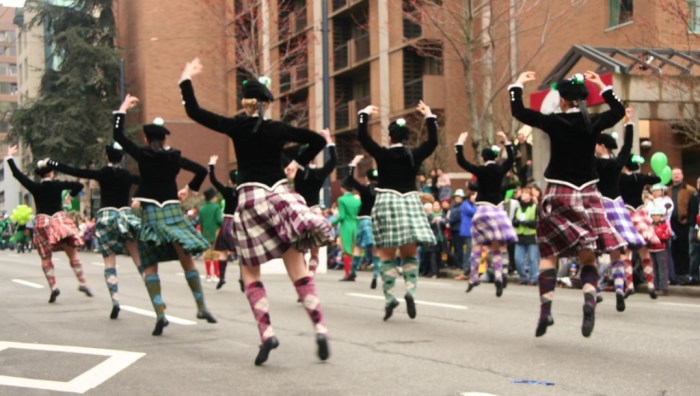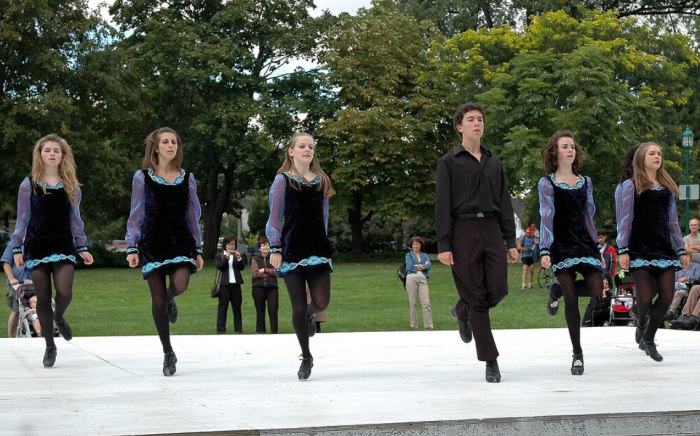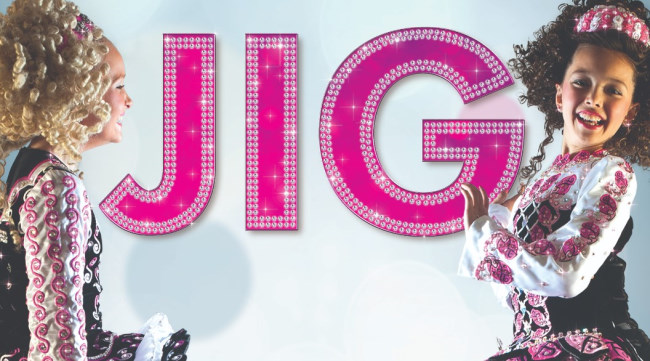If you come to a folk festival or a dance show in Scotland or Ireland, there’s a good chance that you will get to see the Jig dance.
It’s such an important part of the local culture. Some even say that if you haven’t seen a Jig dance performance, you haven’t actually been to Scotland or Ireland.
This guide can be your introduction to this spectacular dance, from giving you its basic history to its dance steps, costumes, and more!
Table of Contents
Jig Dance Definition
The Jig dance (people call it “Jig” for short) is an energetic folk dance. It’s commonly associated with the Irish and Scottish cultures.
The Jig is characterized by having a fun, high-energy disposition, and a very special repertoire. The dancer moves their legs and taps their feet to the beat while having very little torso movement.
You cannot mistake the Jig for any other dance form out there.
Jig Dance Origin
Ireland and Scotland are the regions that are commonly associated with the Jigs.
However (and this may offend many people), most historical documents show that the Jig first appeared in England in the 16th century.
This predecessor to the Jig was usually danced in 12/8 time and was used as a kind of entertaining dance after a play at the theater.
So why is it called Jig?
The English name Jig is possibly a derivative of the French word giguer, meaning “to jump”.
In Ireland, the word jig was probably derived from the Irish Gaelic word jigeánnai, which is also a term borrowed from Old English giga, meaning “old dance”.
Irish Jig and Scottish Jig
In the 17th century, the Jig became extremely popular in Ireland and Scotland. Its popularity endures to this day.
In Ireland, the Jig is the second most popular type of folk dance (the most popular being the reel dance). It is still considered a “popular” folk dance in Scotland, but it’s nowhere near as prevalent as in Ireland.
It’s a common misconception that Irish and Scottish Jigs are the same. In reality, they are two very different forms of dancing.
In Scottish Jig, the dancers move their arms a lot. They even occasionally link their arms together while dancing in a group.
In some performances with many dancers, you can see them making arches with their arms for others to weave underneath.
On the other hand, the Irish Jig is far more “classic”. The dancer uses rapid footwork, with their torso straight and arms held rigidly downward.
And there must be no touching between the dancers!

Irish Jig Dance Steps
There are five distinct steps in the Irish Jig that you should know.
Light Jigs
A Light Jig is second only to the Hop Jig in terms of speed (we’ll discuss the Hop Jig later).
When you see a dancer performing the Light Jig, their feet will lift, but don’t leave the ground for long. Each move of the feet must be short and rapid.
There are several steps that are considered “Light Jig”, but the most popular by far is the rising step (also called the “rise and grind”).
To perform the rising step, a dancer (let’s assume they’re right-footed) will shift their weight onto their left foot. This shift will allow them to lift their right foot. They will then hop on their left foot once.
In the next beat, the dancer will make a second hop on their left foot, bring their right foot behind their left foot, and then shift their weight onto their right foot. The left foot should now be raised into the air.
As you can see, there are two distinct movements in the rising step. Dancers call the first phase the “hop”, and the second phase the “hop back”. There should be a slight pause between each phase.
Once the hop back is performed, the dance will repeat, except this time on the right foot.
Slip Jigs
Slip Jigs use 9/8 time, which has longer measures that result in a slower rhythm dance. It is typically performed on the toes and looks very much like ballet.
For this reason, Slip Jigs have often been called the “ballet of Irish dance”. Other than being danced on the toes, the movements of Slip Jig dancers must also be fluid and graceful.
Single and Double Jigs
Single and Double Jigs are the least common out of all the Jigs. They are usually performed in 6/8 time, but occasionally, they can even be performed in 12/8 time.
What sets the Single and the Double Jig apart is the note pattern.
A Single Jig goes with eighth notes (“quavers”) and is followed by quarter notes (“crochets”). This note pattern gives Single Jigs a very distinctive “skipping” sound.
As for the Double Jig, it uses mostly repeating eighth notes.
Hop Jigs
Hop Jigs are the fastest of all the Jigs.
The naming convention can be a bit confusing for people. Some people also use the term “hop jig” to refer to Single Jigs, while some others use it to indicate a tune in 9/8 time.
Even the classification of Hop Jigs is problematic, some people say it is the same thing as a Slip Jig. Others consider it a special variant of the Slip Jig, which puts emphasis on quarter note-eighth note pairs.
Treble Jigs
Treble Jigs are also called heavy jig or hard jig since it is danced using hard shoes to a 6/8 meter. Dancers usually perform various moves that involve heavy, bassy footwork such as stomps.
It is a fairly slow dance.
At feiseanna (a traditional festival where the Jig is usually performed) beginners dance the treble jig at 92 bpm, called the “traditional” beat.
More experienced dancers will use a “non-traditional” beat, which is around 72 bpm.
American Jig Dance
The Jig isn’t just prevalent in Ireland or Scotland. It can be found in America, as well.
Around the 19th century, the Jig was adopted by African-American slaves and was later picked up by traveling minstrel shows.
This “minstrel jig” (also called “straight jig” to avoid confusion over the Irish dance), is usually danced with syncopated rhythm and very odd, eccentric movements.
It was performed to 2/2 or 2/4 meters at schottische tempo, and the backing music was traditionally produced by the banjo or the fiddle.
The straight Jig’s repertoire shares many similarities with the traditional Irish counterpart.
There is the tapping with the heel or the toe of the shoes, hopping on one foot, and springing on both feet, along with sliding and shuffling.
A popular variant of the straight jig is the “sand jig” or “sanding”.
The basics are the same as a normal performance of a straight Jig. However, the performers will slide and shuffle on a floor strewn with sand.
In some performances and venues, sand can be strewn across the whole stage. But in smaller performances, the sand can be confined in a small box that the dancer has to stay in throughout the performance.
Why sand?
Well, the texture of the sand can modify the sound of the shoe-tapping, giving it a dryer, more distinctive clacking noise than your normal Jig dance.
Did you know: What Is Dabbing Dance?
Jig Dance Attire
In informal dances, Jig dancers can wear whatever they want so long as they have the right dancing shoes. That means you can wear jeans and a T-shirt to dance and no one will call you out for that.
However, during formal events like the feiseanna or dance competitions, if you’re going to dance, then you must wear proper attire.
But depending on what kind of Jig you’re dancing, the attire is going to be different.
Irish Jig Dance Attire
In the Irish Jig dance, the dress code will differ between men and women.
- Men
Men will wear a tailcoat in either red or green.
The tailcoat is worn over a waistcoat, which must have the opposite color of the tailcoat. For example, if the tailcoat is green, the waistcoat must be red, and vice versa.
At the bottom, the dancer wears a pair of knee britches (trousers) and green stockings.
On their feet, they will wear special Jig dance shoes, which can be red, green, or black.
Extra accessories to be worn are a muffler (either in red or have parsley patterning) and a paddy-style hat.
- Women
Women will wear full dresses in either white, red, or green (or a combination of all three colors).
For example, you can mix an ensemble between a green skirt, a white blouse top, and a small, red cape.
A white apron is worn over the dress. Underskirts are made from cotton, along with a white pair of pants.
Dancers will also usually wear tights in red, green, or nude colors.
Jig dance shoes are the last piece. Typically, they don’t come with taps and can be worn in green, red, or black.
Scottish Jig Dance Attire
Similar to the Irish Jig, dancers of the Scottish Jig also wear costumes. The Scottish’s attires are notably different.
Many pieces of clothing are special to the Highland culture. But one thing both regions share is that their costumes are also separated between men and women.

- Men
The men wear a kilt along with the sporran (a type of pocketed belt worn over a kilt). At the top, they will wear a jacket and a bonnet.
And for their feet, they will wear a hose with tartan patterning and, remarkably, a sgian-dubh. The sgian-dubh is a small, ceremonial knife that is worn within the kilt’s hose with the knife’s handle sticking out.
- Women
The women wear a jacket made from velvet and decorated with silver or gold braid edging and buttons. It is worn over a white blouse with lace ruffles around the neck area.
Similar to the men, they will also wear a kilt and tartan-patterned hose. And for their feet, they can wear either ghillies or Jig dancing shoes.
Movies About The Jig Dance
Jig (2011)
The Jig (2011) is a documentary directed by Sue Bourne that revolves around the 40th Irish Dancing World Championship (or Oireachtas Rince na Cruinne.)
A filming crew followed the path of eight dancers as they prepared for and partook in the competition, which, for that year, was held in Glasgow.
From learning about the life of these young competitors, as well as some spectacular jigging dance battles, it has every element of a good dance documentary.
One of the dancers followed by the crew, Julia O’Rourke, won that year’s competition. And thanks to the documentary, she became the face of Irish dancing worldwide thereafter.
It’s a great movie to watch if you’re interested in learning more about the world of Irish dancing, Irish dancer and jig dancing.
Jig (2011) was nominated for many awards, including the British Academy Scotland Awards, the Golden Trailer Awards, and the International Film Music Critics Awards.
Final Words
Jig dancing is a beautiful dance that reflects the vibrant, lovely culture of the people of Ireland and Scotland. If you ever have the opportunity to watch a Jig performance, make sure not to turn it down.
And of course, if you want to practice and become a Jig dancer yourself, it’s never too late to start!

